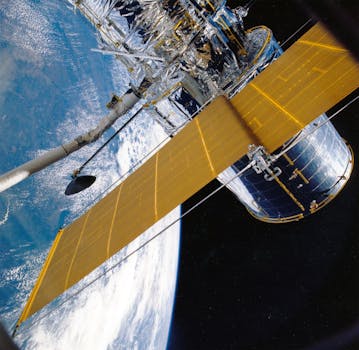Beyond Earth: How Recent Advances Are Shaping Satellite Telecommunications – Recent Advances in Satellite Telecommunications

Recent Advances in Satellite Telecommunications are revolutionizing the way we communicate beyond Earth’s boundaries. The advent of satellite telecommunications has enabled global connectivity, facilitating communication between individuals, organizations, and governments across the globe. In recent years, significant advancements have been made in satellite technology, further expanding the capabilities of satellite telecommunications.
Satellite telecommunications involve the use of artificial satellites orbiting the Earth to transmit and receive data, voice, and video signals. This technology has become increasingly important in modern times, as it provides a means of communication in areas where traditional infrastructure is lacking or unreliable. Recent advances in satellite telecommunications have focused on improving the efficiency, reliability, and accessibility of satellite-based communication systems.
Advances in Satellite Technology
One of the most significant recent advances in satellite telecommunications is the development of high-throughput satellites (HTS). HTS are designed to provide faster data transfer rates and greater connectivity than traditional satellites. They achieve this through the use of advanced technologies such as spot beams, which allow for more efficient use of bandwidth, and phased arrays, which enable the satellite to dynamically adjust its antenna pattern to optimize signal strength.
Another key area of advancement is in the field of satellite propulsion systems. Traditional satellite propulsion systems rely on chemical-based propulsion, which can be heavy, expensive, and inefficient. Recent developments in electric propulsion systems have led to the creation of more efficient and cost-effective satellites. Electric propulsion systems use electrical energy to accelerate ions or xenon gas, generating a high-specific-impulse propulsion system that can achieve greater fuel efficiency and longer mission durations.
Improving Satellite-Based Communication Systems
Recent advances in satellite telecommunications have also focused on improving the reliability and accessibility of satellite-based communication systems. One major development is the introduction of satellite constellations, which involve the deployment of multiple satellites in a coordinated pattern to provide global or regional coverage. Satellite constellations offer several advantages, including improved connectivity, increased redundancy, and enhanced resistance to interference or satellite failure.
Another significant advancement is the development of advanced antenna systems. Traditional satellite antennas are often large, heavy, and inflexible, limiting their use in certain applications. Recent developments in phased array technology and active electronically scanned arrays (AESA) have led to the creation of more compact, agile, and adaptable antenna systems. These advanced antennas can be used to support a wide range of frequencies and applications, including 5G, IoT, and satellite communications.
Challenges and Future Directions
Despite the many advances in satellite telecommunications, there are still several challenges that must be addressed to fully realize the potential of satellite-based communication systems. One major challenge is the issue of space debris, which poses a significant threat to the long-term sustainability of satellite operations. Recent advancements in satellite design and propulsion systems have focused on reducing the amount of debris generated by satellites, as well as developing more efficient methods for de-orbiting and disposing of satellites at the end of their mission life.
Another significant challenge is the need for more efficient and effective spectrum management. The increasing demand for satellite-based communication services has led to a growing need for access to limited radio spectrum resources. Recent developments in spectrum-sharing technologies and advanced frequency allocation methods have helped to mitigate this challenge, but further research and innovation are needed to ensure that spectrum resources are used efficiently and effectively.
In conclusion, recent advances in satellite telecommunications are transforming the way we communicate beyond Earth’s boundaries. The development of high-throughput satellites, advanced propulsion systems, satellite constellations, and advanced antenna systems are just a few examples of the many innovations that are shaping the future of satellite telecommunications. As the demand for global connectivity and communication continues to grow, it is likely that satellite telecommunications will play an increasingly important role in supporting a wide range of applications and services.
Recent Advances in Satellite Telecommunications are paving the way for a more connected and interconnected world. With ongoing research and innovation, it is likely that satellite telecommunications will continue to advance, enabling new and innovative applications and services that will transform the way we live, work, and communicate.




